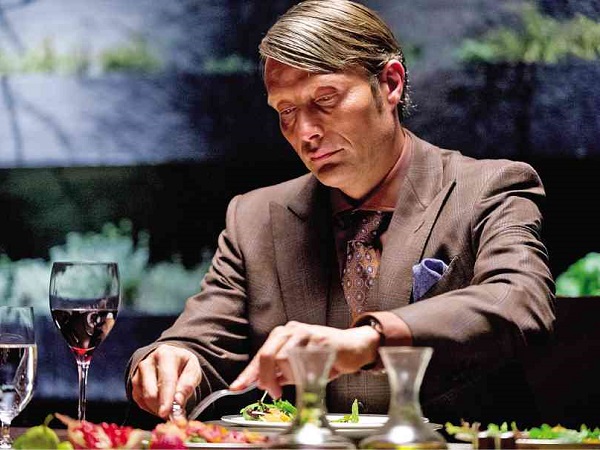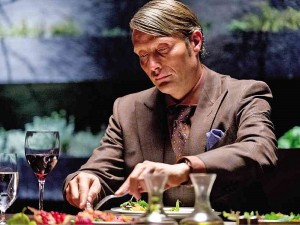
“Let’s start with the morgue,” associate producer Loretta Ramos said, kicking off our tour around the set of “Hannibal,” a new original thriller series which will premiere on AXN on April 8.
It was a cold and snowy Sunday morning in Mississauga, Ontario, but we felt warm inside the converted warehouse studio where “Hannibal’s” TV magic is made—or some of it at least.
On our way to the morgue, we passed by a table covered with plastic containers, rolls of cling wrap and discarded food—pitted tomatoes, grotesque-looking sausages, lettuce leaves, a pomegranate torn in half, chunks of grapefruit and a forlorn lotus root. We gathered around the carnage, snapping so many photos you’d think we were paparazzi chasing Kim Kardashian.

“Wouldn’t it be funny if this was just someone’s breakfast?” someone asked.
Soon we found ourselves inside the show’s FBI headquarters. At the end of the corridor was the FBI seal. To our left were labs which held real medical and forensic equipment that actually work. But no one was looking at the machines.
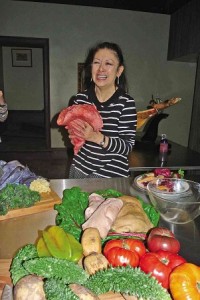
Dead bodies
We were all looking at the bodies. The dead bodies.
There were six of them at the morgue—victims of the serial killers we will see in the show as the season progresses. A woman in pink with hardly any sign of physical injuries; a man whose face had been sliced open from ear to ear; two burn victims; and a limbless man whose throat had been ripped apart. They were prosthetics, we knew that, but they looked so real that we couldn’t help but feel creeped out.
“My God, even the skin looks so real,” whispered one journalist.
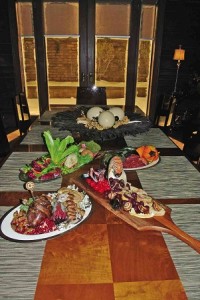
We kept imagining one of the bodies grabbing us as we leaned in for a closer look.
Francois Degenais and his prosthetics team’s fantastic work was so detailed that some of the dummies even had facial stubble.
Matthew Davis, the show’s production designer, said, “Francois is incredibly learned when it comes to human anatomy. We body-cast the actors and he creates something anatomically accurate to the physical injuries that are scripted. The workmanship, putting all the hair, the eyelashes, it really is incredible. On the first day I came to set, there was a prosthetic body and I actually thought it was a real actor. You can see every pore, every broken vein. The detail is incredible.”
The sixth body was on the autopsy table. “Her name is Beth and you’ll be seeing her in the show’s 10th episode.” Like one of the other bodies in the morgue, her face had been cut open, her yellow robe splattered with blood.
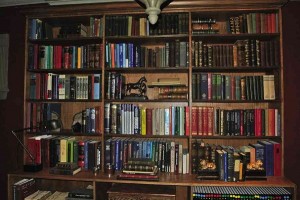
“What do you do with the bodies when you’re done filming?” we asked, and everyone laughed.
“Sometimes they’ll keep the body and reappropriate it,” said Matthew.
“Recycle, reduce, reuse, recycle,” someone else said.
Case files
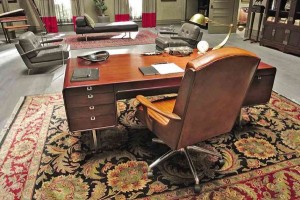
From the morgue we made our way to Will Graham’s turf—the homicide detective-turned-teacher’s office and lecture hall. Thankfully, there were no dead bodies there.
His desk was organized, with folders, notebooks and pens in neat piles. On his dresser were books: Wigmore on Evidence, Illustrated Medical and Health Encyclopedia, the Annotated Code of Maryland and some unmarked volumes. On the floor were boxes of FBI case files.
We stumbled into another room at the FBI headquarters. Maps, surveillance photos, and mug shots were pinned to the walls and active case files were on the table.
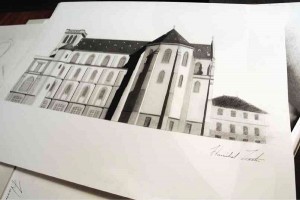
At Jack Crawford’s office we found more maps and diplomas on the walls and even more case files and documents on his desk, cabinets and in the boxes stacked on the floor. The head of the FBI’s Behavioral Science Unit’s office was well-lit and minimalist—no frills, no nonsense.
It was a stark contrast to Hannibal Lecter’s office. The psychologist and cannibalistic serial killer’s space is spectacular, with luxurious furnishing and works of art that included his own sketches. Loretta said, “Obviously, Hannibal is a man of very fine taste with lots of antiques and lots of great books.”
Production designer Patti Podesta, who worked on the show’s pilot, used Baltimore town homes, Sir John Soane’s Museum in London and the state library room of the North Carolina State Capitol as her inspirations in creating Hannibal’s office.
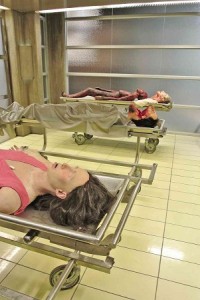
“The idea of this vaulted ceiling, second floor library and functional office downstairs came from the State Library. When Patti, Bryan (Fuller, the show’s creator) and David (Slade, the director) would talk about what kind of space Hannibal would function in, John Soane’s Museum kept coming up. John Soane was an architect who had an eclectic collection of curios, art, everything,” said Loretta.
Noticeable, too, were the black notebooks with color-coded dots on Hannibal’s shelves. “Patti’s idea was that this was Hannibal’s filing system in order to keep his patients’ records confidential. Patti, for the last year, has curated the Stanley Kubrick exhibit that’s currently at the Los Angeles County Museum of Art. The dot filing system was inspired by the Kubrickian card catalog,” Loretta explained.
Food stylist
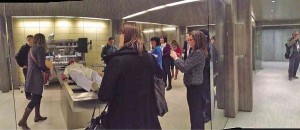
On the wall of the office’s private exit were two framed insects—perhaps a subtle homage to the moth in “Silence of the Lambs?”
We left Hannibal’s office but found ourselves deeper in his world, just a few steps away, in his dark dining room. On the huge table were elaborate plates of food—unidentifiable meats, huge shellfish, slimy seeds and animal bones. The dishes looked both repulsive and delicious.
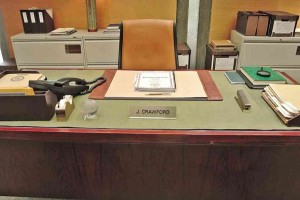
Inside Hannibal’s kitchen, we found Janice Poon, the show’s energetic food stylist, the woman responsible for the bizarre spread we had seen earlier. She said, “Hannibal’s opulent kitchen is practically a surgery theater. He has the sharpest knives. He is a connoisseur and he delights in having the best of everything and eating the best of everything —even if it’s his best friend.”
She explained, “Hannibal eats the rude, the uncivilized. He likes to take the raw and cook it—because cooking, at its very essence, is a refining of things. He’s refining them in the only way he knows how.”
Food plays a big role in this show and Janice has the task of creating the plates featured in each episode. She said, “When making my food for Hannibal, I don’t want to come off too freaky freak-you-out horrible. I want it all to look diabolically delicious, like you just know you shouldn’t eat it but you want to.
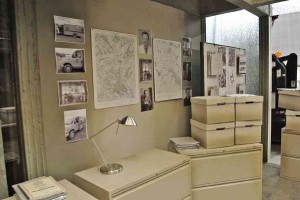
Everything can be ghoulish if you put it in the right context. Vegetables are so creepy. Everything can scare the bejeezus out of you if you put it next to something that kinda makes you think. One of my favorite things is to take something completely ordinary like a lotus root and I’ll put it on a plate with a bird skull. Now where did I put my handy little bottle of blood?”
Someone grabbed it for her and she drizzled the red liquid over the plate in front of her, saying, “It isn’t enough to give just food porn. You have to touch it up with not gore, but just a little something that says, “Is it raspberry coulis or is it Type O?”
Janice clearly enjoys her job: “How do you get a job like this? You pray for it. As a food stylist, it’s a dream job.”
She visits Chinatown, Portuguese stores, an old-fashioned Italian butcher, and a lot of ethnic shops looking for ingredients she can use in the show. She said, “The best thing anybody can say to me when I present Hannibal’s dishes is, “That looks disgusting. Can I taste it?”
That’s exactly what Mads Mikkelsen, the actor who plays Hannibal, has been saying to her. While shooting an episode that showed Hannibal cooking and eating lung, Mads was disappointed that Janice didn’t cook real lung for him. “I made the lung out of mortadella. He came over between takes and said, “What is this?! This tastes like Spam!” If I had only known he wanted lung.”
Janice said Mads is unlike a lot of actors who spit out their food between takes: “He eats everything. He’s fantastic.”
‘Dinuguan’
But Janice’s job is more than just about preparing food that people would want to eat. “Hannibal is constantly lying to you, the only way you’re only going to see what he really means is through the food,” she said. “It will tell you things about Hannibal, about his personality, his motivation. That’s what I’m trying to do with the food.”
On the counter in front of Janice were ingredients that made the other journalists squeamish.
“What is that?” someone asked, pointing to the bitter melon.
“Is that real lung?” people asked repeatedly, as Janice held a cow lung in her hands.
“That’s goat stomach?”
“What do you serve with pig snout?”
“Just a smile,” Janice replied.
We were amused that they were so freaked out by the food when all we could see when we looked at them were ampalaya, bopis, kare-kare and sisig. We told Janice so on our way out of Hannibal’s kitchen. “In the Philippines, a lot of this stuff is just normal food for us. Like this snout, it’s bar food.”
She said, “I know, I know! One of my favorites is your blood pudding—I love it, I love it!” Hannibal’s food stylist is a fan of dinuguan.
The kitchen was our last stop and Janice sent us off with packs of Osso Di Morto that she baked—Italian cookies that look like bones of the dead, traditionally made for All Souls’ Day. “Because every day is day of the dead in Hannibal’s kitchen,” she said. “They’re made with sugar, flour, eggs, cinnamon, no surprise parts.”

